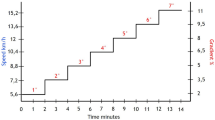Summary
Two research investigations were undertaken to determine the effects of experimental aerobic/circuit weight training (A/CWT) and standard Navy aerobic/calisthenic (A/CAL) training on fitness parameters.
Study I Subjects were 22 female officer and enlisted personnel aged 24 to 34 years (mean=28.2). The women followed a 10-week A/ CWT program working at an intensity of 60% of determined one repetition maximum (1RM). These women showed significant (p<0.05) improvements in dynamic muscular strength, muscular endurance, and stamina. Only upper torso static strength was unaffected by training.
Study IIParticipants were 115 female recruits aged 17 to 34 years (mean=20.4). They were randomly assigned to one of three training groups: 1) aerobic/calisthenic training (A/CAL) (N=58); 2) aerobic/circuit weight training at 40% (A/CWT-40) of maximum strength determined for a single repetition (1RM) of the lifting exercises (N=26); and 3) aerobic/circuit weight training at 70% (A/CWT-70) of determined 1RM (N=30).
Results showed that standard recruit A/CAL training did not significantly (p<0.05) enhance upper torso dynamic strength (except the lat-pull-down test) or stamina. A/CWT-70 elicited significantly (p<0.05) higher gains in several tests of upper torso strength than A/CAL or A/CWT-40. These results suggest that A/CWT offers a way to develop the required upper torso strength of Navy women.
Similar content being viewed by others
References
American College of Sports Medicine Position Statement on Recommended Quantity and Quality of Exercise for Developing and Maintaining Fitness in Healthy Adults (1978). Medicine and Science in Sports 10: 1:vii-x
Berger RA (1961) Comparison of static and dynamic strength increases. Res Quart 33:329–333
Brown CH, Wilmore JH (1974) The effects of maximal resistance training on the strength and body composition of women athletes. Med Sci Sports 6:174–177
Cunningham DA, McCimmon D, Vlach LF (1979) Cardiovascular responses to interval and continuous training in women. Eur J Applied Physiol 41:187–197
Drinkwater BL (1973) Physiological responses of women to exercise. In: Wilmore JH (ed) Exercise and sport sciences reviews, vol 1. Academic Press, New York, pp. 125–153
Hanson JS, Nedde W (1974) Long-term physical training effect in sedentary females. J Applied Physiol 37:112–116
Hodgdon JA, Beckett M (1983) Another validation of the RSG4 maximal work capacity test. Summaries of the 4th NATO RSG4 Physical Fitness Meeting with Special Reference to Military Forces, Brussels, Begium. NATO Report DS/A/DR(83)73, pp 12–13
Hoiberg A (1980) Women in the Navy: performance, healthy, and motherhood. Changing U.S. Military Manpower Realities. Westview Press, Inc Boulder, CO
Hull CH, Nie NH (1981) SPSS Update 7-9. McGraw-Hill, San Francisco
Instructor Guide for U.S. Navy Recruit training. NAVCRUI-TRACOMSDIEGOINST 5400.17D
Laubach L (1976b) Muscular strength of women and men: a comparative study. AMRL-TR-75-32. Aerospace Medical Research Laboratory, Wright-Patterson Air Force Base, Ohio
Linton M, Gallo PS (1975) The Practical Statistician: Simplified Handbook of Statistics. Brooks/Cole Publishing Co, Monterey, CA
Marcinik EJ (1984a) SPARTEN: A total body fitness program for health and physical readiness. Naval Health Res Cent, San Diego, CA, Report No. 84-38
Marcinik EJ, Hodgdon JA, Mittleman K, O'Brien JJ (1984b) Aerobic/calisthenic and aerobic/circuit weight training programs for Navy men: a comparative study. Naval Health Res Cent, San Diego, CA, Report No. 84-6
Murphy MA, Nemmers TM (1978) Ammunition loading and firing test — pretest physical conditioning of female soldier participants. Technical Note 11–78, U.S. Army Human Engineering Lab, Aberdeen Proving Ground, MD
Myles WS, Toft RJ (1982) A cycle ergometer test of maximal aerobic power. Eur J Applied Physiol 49:121–129
Pollock ML (1973) The quantification of endurance training program. In: Wilmore JH (ed), Exercise and sport sciences Reviews, vol 1. Academic Press, New York, pp 155–158
Robertson D (April 1982) Development of an occupational strength test battery (STB). Navy Personnel Res and Dev Center TR-82-42
Robertson D (2–4 May 1983) Relationship of dynamic strength, static strength, and body weight to mental and muscular tasks. Proceedings of the 24th DRG Seminar on The Human as a Limiting Element in Military Systems. Toronto, Canada
Rogosa D (1981) On the relationship between the Johnson-Neyman region of significance and statistical tests of parallel within-group regressions. Educat Psychol Measurement, pp 140–146
Tatsuoka MM (1971) Multivariate analysis. Wiley, New York
Walker HM, Lev J (1953) Statistical inference. Holt, Rinehart & Winston, New York
Wilmore JH (1974) Alterations in strength, body composition and anthropometric measurements consequent to a 10-week weight training program. Med Sci Sports 6:133–138
Author information
Authors and Affiliations
Additional information
This research was supported by the Naval Medical Research and Development Command, Department of the Navy, under research work unit M0096-PN.001-1044. The views presented in this paper are those of the authors. No endorsement by the Department of the Navy has been given or should be inferred
Rights and permissions
About this article
Cite this article
Marcinik, E.J., Hodgdon, J.A., O'Brien, J.J. et al. Fitness changes of naval women following aerobic based programs featuring calisthenic or circuit weight training exercises. Europ. J. Appl. Physiol. 54, 244–249 (1985). https://doi.org/10.1007/BF00426140
Accepted:
Issue Date:
DOI: https://doi.org/10.1007/BF00426140




